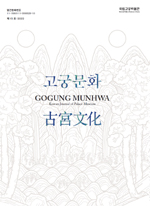학술논문
국립고궁박물관 소장 금보의 재질 특성 및 제작 기법 연구
이용수 20
- 영문명
- A Study on the Material Characteristics and Manufacturing Techniques of the Gold Seals in the National Palace Museum of Korea
- 발행기관
- 국립고궁박물관
- 저자명
- 강승희 박대우 김민지 권혁남
- 간행물 정보
- 『고궁문화』제15호, 153~171쪽, 전체 19쪽
- 주제분류
- 인문학 > 역사학
- 파일형태
- 발행일자
- 2022.12.14
무료
구매일시로부터 72시간 이내에 다운로드 가능합니다.
이 학술논문 정보는 (주)교보문고와 각 발행기관 사이에 저작물 이용 계약이 체결된 것으로, 교보문고를 통해 제공되고 있습니다.

국문 초록
국립고궁박물관에 소장된 어보는 총 322점으로, 15세기부터 20세기까지 조선왕실과 대한제국 황실에서 제작되었다. 본 연구에서는 국립고궁박물관에 소장된 155과 금보의 표면 관찰, 내부 구조 조사, 성분 분석을 하였다. 금보 분석 결과는 조선왕조 의궤에 기록된 어보 제작 시기를 바탕으로 정리하였으며, 시대 흐름에 따라 금보에 사용된 재료 및 제작 기법에서 변화 양상이 나타나는 것을 확인하였다. 금보는 구리 합금, 은 합금, 주석 합금으로 만든 주물에 수은 아말감 기법으로 도금하여 제작하였다. 금보는 약 93%가 구리 합금으로 제작되었으며, 시기별로 아연 함량이 달라진다. 15세기부터 18세기 초기까지 제작된 금보는 아연 함량이 10% 초반을 넘지 않으나, 18세기 중기 이후에 제작된 금보의 아연 함량은 10~30%로 넓게 분포하며, 특히 19세기는 20~30% 이상의 함량을 지닌 금보가 많이 제작되었다. 금보의 보뉴 형태는 귀뉴, 용뉴, 직뉴로 구분되며, 이 중 귀뉴형 금보는 15세기부터 20세기에 걸쳐 제작된 대표적인 금보로 귀갑문에서 시기별 특징이 나타난다. 대부분 금보의 귀갑문에는 문양 없이 귀갑만이 새겨져 있으나, 17세기 후기부터 19세기 초기까지 제작된 금보에서만 귀갑 내 장식한 문양이 나타난다. 또한, 금보는 18세기 후기 이후에 보뉴와 보신의 제작 방법이 일체형 주조에서 분리형 주조로 변화되는 양상이 관찰된다.
영문 초록
There are a total of 322 royal seals in the collection of the National Palace Museum of Korea, which were produced by the royal family of the Joseon Dynasty and the royal family of the Korean Empire from the 15th to the 20th century. In this study, surface observation, internal structure investigation, and compositional analysis of 155 gold seals in the National Palace Museum were conducted. The results of the analysis of the gold seals were organized based on the time of production of the royal seals recorded in the royal books of the Joseon Dynasty, and it was confirmed that the materials and manufacturing techniques used for the gold seals showed changes according to the passage of time. Gold seals were cast with copper alloy, silver alloy and tin alloy and then amalgam plated. About 93% of gold seals were made of copper alloy, and the zinc content varies by period. Gold seals produced from the 15th century to the early 18th century contained no more than 10% of zinc, but the zinc content of gold seals produced after the middle of the 18th century ranged from 10~30%. Especially in the 19th century, many gold seals with a higher content, 20~30%, were produced. The handle form is divided into turtle, dragon, and no character. Among them, the turtle-shaped seals are representative of those produced from the 15th century to the 20th century, and the particular characteristics of each period appear in the turtle pattern. Most of the seals do not have a pattern inside the turtle shell, but the decorative pattern inside the back of the turtle appears in seals made from the late 17th century to the early 19th century. Also, the seals were cast all at once until the 18th century, but after that, they were separately manufactured and welded.
목차
Ⅰ. 머리말
Ⅱ. 분석대상 및 방법
Ⅲ. 분석결과
Ⅳ. 맺음말
키워드
해당간행물 수록 논문
- 경복궁 사정전 <쌍룡도> 벽화의 설치 배경과 제작 시기 검토
- 국립고궁박물관 소장 왕실발기의 현황(1)
- 조선 후기 위기 담론이 고려해야 할 몇 가지 유의사항
- 창덕궁 유물 봉황인문보鳳凰引紋袱에 시문된 문양 분석
- 18세기 후기 운보문 어보 보자기의 문양 분석
- 조선왕실 현판의 사롱紗籠과 문門에 대한 고찰
- 고종조 중창된 경복궁 후원 규모 및 건축 구성에 관한 연구
- 국립고궁박물관 소장 금보의 재질 특성 및 제작 기법 연구
- 조선 19세기 공예품에 나타난 단청 양식 칠보문의 의의
- 정조正祖, 1776~1800대 어보御寶 제작 장인의 변화와 특징
- 고궁문화 제15호 목차
참고문헌
교보eBook 첫 방문을 환영 합니다!

신규가입 혜택 지급이 완료 되었습니다.
바로 사용 가능한 교보e캐시 1,000원 (유효기간 7일)
지금 바로 교보eBook의 다양한 콘텐츠를 이용해 보세요!





